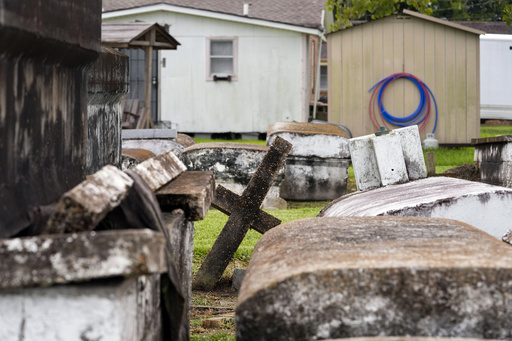
The drive to develop the ammonia facility has sparked controversy, especially as it aligns with a significant climate law endorsed by President Joe Biden. The company behind the project purports that nearly all of the carbon dioxide emissions resulting from ammonia production will be captured and stored underground. However, environmental activists are skeptical of these claims and argue they are overly optimistic.
The Tulane University Environmental Law Clinic has urged the Louisiana Department of Environmental Quality (LDEQ) to withdraw itself from the process of considering the permit for St. Charles Clean Fuels’ proposed plant adjacent to Elkinsville. The clinic asserts that the department has seemingly preemptively decided to approve the permit without adequately considering public feedback – an action which they claim contradicts Louisiana law.
This legal maneuver followed a public hearing in St. Charles Parish last month that had to be cut short due to overcrowding; over 150 individuals attempted to attend the meeting at a local library. The LDEQ described the turnout as a coordinated effort aimed at impeding economic growth within the state and local areas.
Despite planning to reschedule this hearing for late December and to deliberate on public remarks, residents like Kimbrelle Kyereh express skepticism regarding the commitment of Louisiana’s environmental officials to safeguard their community. Kyereh highlighted her ongoing complaints about noxious fumes emanating from a nearby chemical storage facility, feeling that her concerns have largely been ignored.
If the LDEQ does resign from the decision-making process, the responsibility would shift to Governor Jeff Landry, a strong proponent of Louisiana’s petrochemical sector, to appoint a different entity to evaluate the permit application.
Elkinsville is a neighborhood with a significant historical background, having been founded by free Black individuals situated at the fringes of an old plantation site near the Mississippi River. In the past century, land that was once part of the plantation was converted into an oil export terminal. Currently, the International-Matex Tank Terminals operates a substantial tank farm nearby, storing fuels and chemicals.
This tank farm is alarmingly close, only separated by a chain-link fence from residents’ homes.
Community members have expressed concerns that the impending ammonia facility would exacerbate existing health issues linked to nearby industrial activities. They report waking up gasping for air and having to keep their windows shut due to unbearable odors.
Rose Wilright, an 80-year-old Elkinsville lifelong resident, holds affection for her neighborhood and recounts memories of family gathered around a local cemetery. However, she fears that the industrial presence has led to health challenges, including her grandson’s asthma and her own issues requiring albuterol. “It’s just devastating that they’re trying to bring more chemicals on us,” she lamented.
The ammonia plant plans to utilize tanks managed by IMTT for storage. The CEO of IMTT, Carlin Conner, has responded to these community grievances, insisting they take residents’ concerns seriously and attempting to address them. He noted that while unpleasant odors are acknowledged, they do not consider these to be health-threatening.
To mitigate noxious emissions, IMTT has made investments in advanced venting systems and has engaged in community support initiatives, including contributions to local charities and youth training programs.
While some residents acknowledge the economic advantages brought by IMTT, they continue to fear the potential consequences of further industrial expansion. Last year, IMTT was reported to have released over 100,000 pounds of toxic volatile organic compounds, surpassing the threshold defining a major source of pollution in Louisiana.
St. Charles Clean Fuels, primarily funded by the Danish investment firm Copenhagen Infrastructure Partners, has claimed its ammonia facility will create 200 permanent jobs and produce 8,000 metric tons of ammonia daily, with projected annual emissions of about 118,700 pounds of ammonia.
This ammonia initiative benefits from federal incentives recognized in the 2022 Inflation Reduction Act, providing potential tax credits for carbon emissions captured and stored.
Although ammonia is essential for fertilizers, it is also being promoted as a future fuel source. The plant aims to minimize climate impact by implementing carbon capture technologies, with hope to prevent 5 million tons of carbon dioxide from escaping into the environment each year.
Environmental advocates generally remain skeptical toward carbon capture and storage approaches, suggesting that the path toward reducing carbon emissions should avoid dependence on natural gas and raise concerns about the adequacy of carbon capture rates touted by companies.
Michael Levien, a sociologist from Johns Hopkins University studying the Elkinsville region, argues that reliance on the Inflation Reduction Act is aggravating pre-existing environmental and racial injustices, as it incentivizes industrial development in areas already suffering from pollution.
Amidst this contentious scenario, the Biden administration is attempting to address issues related to air quality and environmental justice in Louisiana, an area known for its historical impact on Black communities. The EPA recently imposed a fine on IMTT for inadequate safety measures and failure to conduct appropriate assessments, although the company claims to have since improved its procedures.
The LDEQ maintains that air quality measurements in Elkinsville, taken between 2018 and 2023, confirmed safety, leading the agency to remove its air monitoring equipment.
Kim Terrell, an environmental scientist with the Tulane law clinic, highlighted that LDEQ focused only on a limited range of pollutants in its monitoring efforts. Their evaluations indicated elevated levels of dangerous chemicals like n-hexane and naphthalene around the IMTT facility.
Terrell criticized Louisiana’s regulatory framework for these substances, which assumes exposure will be limited to short work shifts, in contrast to the continuous exposure faced by community residents.
The Louisiana authorities argued that comparing state regulations to EPA standards is inappropriate because their protocols prioritize short-term exposure metrics instead.
IMTT has started collaborating with a local environmental organization to set up additional air monitoring stations, although Terrell asserts that the planned system may not meet national standards.
For long-time resident Wilright, the ongoing industrial presence is intolerable. She expressed a desire to leave Elkinsville for a place devoid of chemical plants, despite her deep ties and memories in the community.
